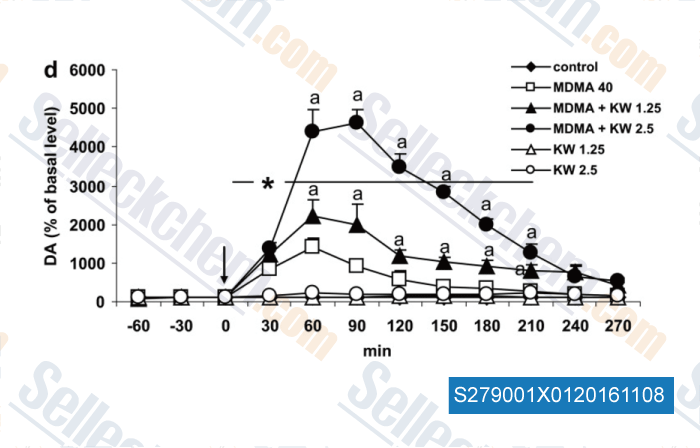|
Toll Free: (877) 796-6397 -- USA and Canada only -- |
Fax: +1-832-582-8590 Orders: +1-832-582-8158 |
Tech Support: +1-832-582-8158 Ext:3 Please provide your Order Number in the email. |
Technical Data
| Formula | C20H24N4O4 |
||||||||||
| Molecular Weight | 384.43 | CAS No. | 155270-99-8 | ||||||||
| Solubility (25°C)* | In vitro | DMSO | 6 mg/mL (15.6 mM) | ||||||||
| Water | Insoluble | ||||||||||
| Ethanol | Insoluble | ||||||||||
| In vivo (Add solvents to the product individually and in order) |
|
||||||||||
|
* <1 mg/ml means slightly soluble or insoluble. * Please note that Selleck tests the solubility of all compounds in-house, and the actual solubility may differ slightly from published values. This is normal and is due to slight batch-to-batch variations. * Room temperature shipping (Stability testing shows this product can be shipped without any cooling measures.) |
|||||||||||
Preparing Stock Solutions
Biological Activity
| Description | Istradefylline (KW-6002) is a selective adenosine A2A receptor (A2AR) antagonist with Ki of 2.2 nM. Phase 3. | ||
|---|---|---|---|
| Targets |
|
||
| In vitro | The affinity of Istradefylline for the A2AR is 70-fold greater than that for the A1 receptor with Ki of 2.2 nM versus 150 nM. [1] Exposure of primary rat striatal astrocytes to Istradefylline results in concentration-dependent abolition of bFGF induction of astrogliosis in vitro. [5] Binding affinities (Ki) of Istradefylline for A1 receptor, A2A receptor, and A3 receptor in human are >287 nM, 9.12 nM, and >681 nM, respectively, for A1 receptor and A2A receptor in rat 50.9 nM and 1.57 nM, respectively, and for A1 receptor and A2A receptor in mouse 105.02 nM and 1.87 nM, respectively. [6] |
||
| In vivo | Istradefylline reverses CGS21680-induced and reserpine-induced catalepsy with ED50 of 0.05 mg/kg and 0.26 mg/kg, respectively. Istradefylline is over 10 times as potent in these models compared to other adenosine antagonists and dopamine agonist drugs. Administration of Istradefylline in combination with LevoDOPA (50 mg/kg) exerts prominent effects on haloperidol-induced and reserpine-induced catalepsy. [2] Oral administration of Istradefylline at 10 mg/kg to MPTP-treated common marmosets produces an increase in locomotor activity to approximately twice that of control and improves motor disability. Administration of Istradefylline (10 mg/kg, po, 90 minutes before SKF80723/quinpirole/LevoDOPA) in combination with SKF80723 (1 mg/kg, ip), quinpirole (0.06 mg/kg ip), or LevoDOPA (2.5 mg/kg po) produces a significant additive effect on locomotor activity and improvement of motor disability but not dyskinesia. [3] In the MPTP mice model, Istradefylline significantly attenuates striatal dopamine depletion under various conditions. Pretreatment with Istradefylline (3.3 mg/kg, i.p.) before a single dose of MPTP attenuates the partial dopamine and DOPAC depletions measured in striata 1 week later. [1] Oral administration of Istradefylline protects against the loss of nigral dopaminergic neuronal cells induced by 6-hydroxydopamine in rats, and prevents the functional loss of dopaminergic nerve terminals in the striatum and the ensuing gliosis caused by MPTP in mice. [4] Chronic Istradefylline treatment does not improve the reversal deficits in dopamine-depleted rats. [7] The tremulous jaw movements induced by pimozide are significantly reduced by co-administration of either Istradefylline or tropicamide. Pimozide-induced increases in ventrolateral striatal c-Fos expression are reduced by a behaviorally effective dose of Istradefylline, in contrast to tropicamide by which c-Fos expression in pimozide-treated rats is actually increased. [8] |
Protocol (from reference)
| Animal Study: |
|
|---|
References
Customer Product Validation

-
, , Neurotox Res, 2015, 27(3):229-45.
Selleck's Istradefylline has been cited by 8 publications
| Clustering Mycobacterium tuberculosis-specific CD154+CD4+ T cells for distinguishing tuberculosis disease from infection based on single-cell RNA-seq analysis [ J Infect, 2025, 90(4):106449] | PubMed: 40010539 |
| Organoid drug profiling identifies methotrexate as a therapy for SCCOHT, a rare pediatric cancer [ Sci Adv, 2025, 11(9):eadq1724] | PubMed: 40009666 |
| Transcriptional control of pancreatic cancer immunosuppression by metabolic enzyme CD73 in a tumor-autonomous and -autocrine manner [ Nat Commun, 2023, 14(1):3364] | PubMed: 37291128 |
| CD39 pathway inhibits Th1 cell function in tuberculosis [ Immunology, 2022, 10.1111/imm.13493] | PubMed: 35574713 |
| MTAP loss correlates with an immunosuppressive profile in GBM and its substrate MTA stimulates alternative macrophage polarization [ Sci Rep, 2022, 12(1):4183] | PubMed: 35264604 |
| Functional and Therapeutic Relevance ofMTAPDeletion in Glioblastoma [ proquest, 2019, ] | PubMed: None |
| A2A Receptor Activation Attenuates Hypertensive Cardiac Remodeling via Promoting Brown Adipose Tissue-Derived FGF21. [ Cell Metab, 2018, 28(3):476-489] | PubMed: 30017353 |
| The Role of Adenosine A1 and A2A Receptors in the Caffeine Effect on MDMA-Induced DA and 5-HT Release in the Mouse Striatum. [Gorska AM, et al. Neurotox Res, 2015, 27(3):229-45] |
RETURN POLICY
Selleck Chemical’s Unconditional Return Policy ensures a smooth online shopping experience for our customers. If you are in any way unsatisfied with your purchase, you may return any item(s) within 7 days of receiving it. In the event of product quality issues, either protocol related or product related problems, you may return any item(s) within 365 days from the original purchase date. Please follow the instructions below when returning products.
SHIPPING AND STORAGE
Selleck products are transported at room temperature. If you receive the product at room temperature, please rest assured, the Selleck Quality Inspection Department has conducted experiments to verify that the normal temperature placement of one month will not affect the biological activity of powder products. After collecting, please store the product according to the requirements described in the datasheet. Most Selleck products are stable under the recommended conditions.
NOT FOR HUMAN, VETERINARY DIAGNOSTIC OR THERAPEUTIC USE.
